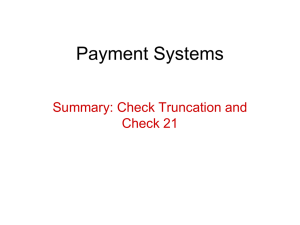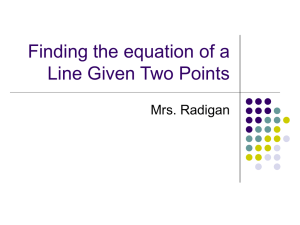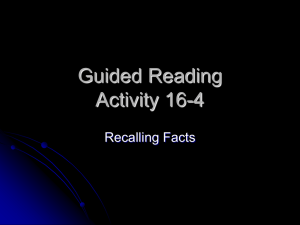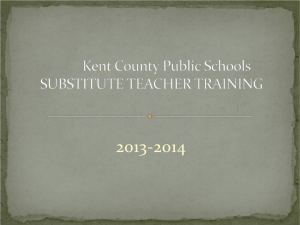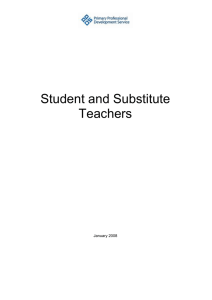A Report and Recommendations to Professionalize Substitute
advertisement
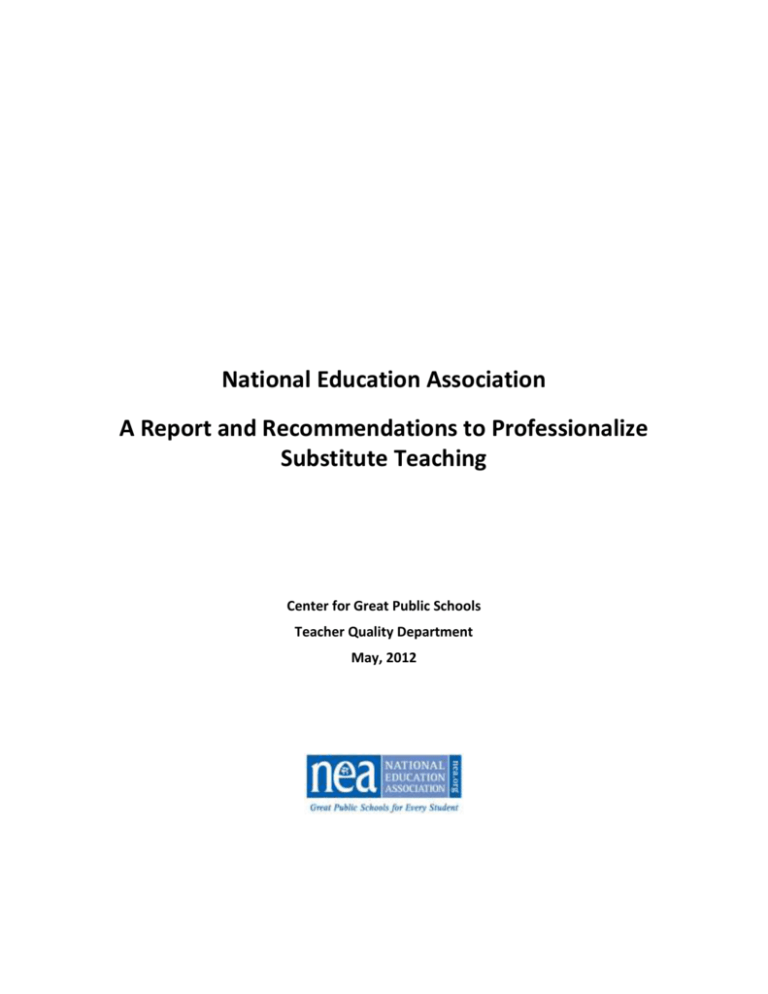
National Education Association A Report and Recommendations to Professionalize Substitute Teaching Center for Great Public Schools Teacher Quality Department May, 2012 The National Education Association (NEA), the nation's largest professional employee organization, is committed to advancing the cause of public education. NEA's 3 million members work at every level of education—from pre-school to university graduate programs. NEA has affiliate organizations in every state and in more than 14,000 communities across the United States. NEA Executive Committee Members Dennis Van Roekel, President Lily Eskelsen, Vice-President Rebecca Pringle, Secretary-Treasurer Greg Johnson Christy Levings Paula Monroe Princess Moss Joyce Powell Earl Wiman John C. Stocks, Executive Director While every attempt was made to ensure the accuracy of the data in this report, it is possible that errors have occurred. Please communicate reports of any errors or comments you may have about the report, as well as any updated information to: Linda Davin, NEA Teacher Quality Department, at ldavin@nea.org. Becoming a substitute teacher is not very hard. In fact, you don't actually have to have a degree in order to do it, but you should probably be out of high school before you try to apply. You're going to probably get paid about minimum wage to do this substitute teacher job, so it's almost like volunteering. If you're trying to substitute in order to find out if you want to be a teacher, know that this class belongs to another teacher, so it's going to be harder for you to sort of teach them anything…. you're going to be more of a stand in, and it's really not going to feel completely like having your own class. So the best way, the best route, to becoming a teacher is going to be actually going to get your teaching degree and doing some student teaching because subbing is a lot more like, well frankly, babysitting in many cases. But it's a good thing to do in your spare time, if you enjoy doing that kind of thing, and you need a little part time job, so good luck subbing. “How to become a substitute teacher” from the eHow site While significant time and attention has been spent on improving teaching and learning in America’s public schools over the past 25 years, there is one part of the education equation that is rarely addressed: the important role that substitute teachers play in America’s public schools. No one can say with certainty the number of hours substitute teachers spend in America’s classrooms, but the number is substantial. Classroom teachers are absent from the workplace for all of the usual reasons employees use leave: illness or medical appointments for themselves or family members, personal leave, and even short-term military service. Plus, in many districts, teachers are scheduled to be out of the classroom for professional development activities or because they have taken on roles related to school improvement or reform, such as curriculum development, mentoring responsibilities, or peer assistance and review. Substitute teachers serve as educational bridges The Association recognizes that effective substitute teachers make a significant contribution to the school program. They serve as educational bridges when regular classroom educators are absent. Shortterm substitutes, who are called early in the morning, take over lessons with short notice and ensure that quality education is maintained in our classrooms. Those who are replacing the regular teacher for long-term assignments take on more responsibility for lesson planning and the many responsibilities that go along with instruction and classroom management. But no matter whether the teaching assignment lasts a single day or several months, the professional substitute aims to make sure that classroom time is productive and that students continue learning. It is in everyone’s interest—students, parents, regular teachers, and the community—that school districts hire qualified individuals as substitute teachers and support them in their work with students. As part of its commitment to helping build a qualified, diverse teacher workforce so that all students have access to great public schools, the Association urges school districts to employ highly qualified individuals to fulfill the critical role of substitute teachers. NEA | A Report and Recommendations to Professionalize Substitute Teaching 1 What are the qualifications needed to become a substitute teacher? The reality is that it depends on where you live. A few states set high standards for substitute teaching— but most do not. Some states specify minimum credentials and training, while others leave the issue entirely to the discretion of local districts or counties. Requirements vary greatly from district to district, although some may require significantly higher credentials than a state’s meager guidelines, which may require only that substitutes be at least 18 years of age and have the equivalent of a high school diploma. Even those states with professional standards for substitute teachers often allow schools or districts facing a substitute shortage to waive requirements. A summary of state requirements for substitute teachers, published in 2010 by the Substitute Teaching Institute at Utah State University, confirms the lack of consistency on this issue (http://stedi.org/common/documents/state-requirements-for-substitute-teachers-2010.pdf). Some states issue certificates or licenses or permits for substitute teachers, while others do not. Alaska, for example, does not issue substitute teacher certificates, although it deems retired teachers to be qualified as substitute teachers. At least two states—Kentucky and Nebraska—make a distinction between a state license and one that is authorized by the local district. Nebraska issues a state substitute teacher certificate for those with a BA in education, but local districts issue their own certificates for individuals with at least 60 hours of college credit. The variability in policy continues across other issues related to employment of substitute teachers. Some states set limits on the number of days that a substitute educator may be in a single assignment; many require background checks; some make a distinction between long- and short-term teaching assignments. Few specify any pre-employment training, and fewer still even raise the issue of evaluation. It is important to note that districts may set higher standards for the employment of substitute teachers than what is required by the state. According to the Substitute Teaching Institute: 27 states (Ala., Ariz., Colo., Del., Hawaii, Ill., Ind., Iowa, Kans., Ky., Mich., Minn., Miss., Mo., Neb., Nev., N.M., N.D., Ohio, Okla., Ore., Pa., R.I., Wash., W. Va., Wis., and Wyo.) and D.C. offer some sort of license, permit, authorization, or certificate for substitute teachers. A few states offer more than a single type of substitute permit, which varies according to the minimum education requirements. 19 states (Ariz., Calif., Conn., Del., Hawaii, Iowa, Kan., Ky., Minn., Miss., Neb., N.D., Ohio, Ore., Pa., R.I., Wash., W.Va., and Wis.) and D.C. note that a bachelor’s degree is needed—but also offer waivers or ways to get around the requirement. States that do not require a college degree sometimes specify a minimum number of college credits hours. 6 states (Ala., Colo., N.M., Utah, Vt., and Va.) specifically note that a high school diploma (or its equivalent) is required. 17 states (Ala., Ariz., Calif., Hawaii, Idaho, Ind., Maine, Mich., Mo., Neb., Nev., N.M., N.D., Pa., Va., W.Va., and Wyo.) plus D.C. mandate that applicants pass a criminal background and/or fingerprint check 4 states (Hawaii, Va., W.Va., and Wis.) require some minimal training or orientation Rhode Island requires districts to advertise for certified substitute teachers Wyoming says those wishing to earn a substitute teacher permit must take a U.S./Wyoming constitution or equivalency test NEA | A Report and Recommendations to Professionalize Substitute Teaching 2 New Mexico says substitute teachers must be 18 years of age to work in a K-8 environment and 21 years of age for grades 9-12; Virginia says that 18 is the minimum age but that age 21 is preferred. With such a hodgepodge of state policies and district procedures, it’s clear that drawing more qualified individuals into substitute teaching will require action on several levels. Districts need to place a higher priority on finding and employing qualified substitute teachers as well as on managing and supporting them. Some districts, for example, assign substitute teachers to regular positions for extended periods of time because that is less costly than employing licensed teachers. Others pull resource teachers from their regular assignments and use them as substitutes. Some districts use ESPs to replace the regular classroom teacher. The bottom line is that students deserve to be taught every day by a qualified teacher, even when the regular classroom teacher is absent. In order to professionalize substitute teaching and make it more appealing to those with at least a college degree, these issues must be addressed: Salaries and benefits. In many places, rural districts especially, salaries are low, hovering just above minimum wage. In urban areas, the rates tend to be somewhat higher. Some districts pay substitute teachers based on qualifications. In Carroll County, Maryland, for example, the pay rate for substitute teachers for 2011-2012 looks like this: o o o o o Certificated: $105 per day (hourly rate is $15) Degreed: $85 per day (hourly rate is $12.14) Non-degreed: $78 per day (hourly rate is $11.14) Long-term degreed: $95 per day (10-20 consecutive days in the same assignment, retroactive to the first day). Extended long term: $100 per day (21 or more consecutive days in the same assignment, not retroactive). Professional training and development. Substitute educators need more opportunities to build their instructional practice and classroom management skills. Support from principals and others in the school. Substitutes can do a better job when they are considered part of the educational team rather than being isolated or invisible in the school. Communication between substitutes and administrators, as well as the regular classroom teacher. Full, unbiased consideration for contractual employment. Association recommendations to professionalize substitute teaching Strengthen state policies on substitute teaching Every state should have policies in place on the employment of substitute teachers. States should give priority to those holding a teaching credential, although all substitutes should be required to hold a bachelor’s degree. Districts should be required to provide pre-employment training to all substitute teachers. See the appendix for sample state language on these and other issues related to substitute teaching. NEA | A Report and Recommendations to Professionalize Substitute Teaching 3 Find ways to draw more qualified individuals into substitute teaching Encourage school systems to review existing substitute programs and protocols and develop practical plans to draw more qualified substitutes into the schools. Create incentives for retired teachers or non-working certified teachers to serve as substitute teachers. For example: Indianapolis Public Schools (IPS) pays substitute with a teaching license more than those with a college degree and those who have retired from IPS more than other retired teachers. Here is the pay scale for the 2012-13 school year: o BS+ Degree: $100 per day o Valid (Current) Indiana Teacher License: $125 per day o Retired Teacher (Non IPS): $125 per day o Retired Teacher (IPS): $150 per day For example: The Rockwood School District in Eureka, Mo., says retired teachers may teach 550 hours as substitutes without being penalized by the Retirement Board. Encourage districts to recruit candidates with preferred qualifications, giving them status as permanent substitutes or building substitutes so that they can develop relationships with students and staff. For example: Anne Arundel County Public Schools in Maryland hires permanent substitutes, who are defined as “permanent employees with benefits who are assigned to one school for the purpose of filling in for a teacher on leave.” Improve compensation and benefits Raise pay for all substitutes and offer bonuses (longevity pay) after a certain number of days as a substitute. Montgomery County (Md.) Education Association contract language on salaries (2010-2014): Long-term substitutes having worked 45 days in the same assignment shall be paid 10 percent higher than the regular long-term rate for the remainder of the assignment. Any substitute teacher who works a minimum of 45 days (315 hours) during a semester shall receive a bonus of $450 at the conclusion of the semester. United Educators of San Francisco contract language on salaries (2010-2012): Each year substitutes shall begin with the “1-70” day rate of pay, provided that upon reaching 71 days the first seventy days become retroactively paid at the “71 or more” rate of pay. K-12 substitute teachers who serve ten (10) or more consecutive days in the same class for the same absent teacher shall be paid a daily bonus. The bonus shall be retroactive to the first day of the assignment. NEA | A Report and Recommendations to Professionalize Substitute Teaching 4 Health care and other benefits should be offered to permanent or long-term substitute teachers once they have taught a certain number of days in the district. Cambridge (Mass.) Teachers Association contract language on health benefits (2009-2012): A building substitute, while employed in that capacity, shall be eligible for health insurance benefits in accordance with the standard plans provided by the employer. The employer shall pay 70% of the premium cost of health insurance benefits, and the employee shall pay 30% of the cost. Place substitute teachers who hold a license in the subject area in which they will be substituting on the appropriate place on the salary schedule. If the person holds a teaching license in another area, the person should be paid at least the beginning rate on the salary schedule. A person who holds a substitute license should be paid at the substitute rate. For example: In Oregon, the daily minimum salary for substitute teachers is set by the legislature at 85 percent of the average beginning teacher. A substitute cannot be paid for less than a half day; work beyond a half day becomes a whole day. After 10 days in one assignment, the substitute teacher is paid the daily salary of a beginning teacher in the district. Provide pre-employment training to substitute teachers States should require pre-employment training. One example is the Wisconsin Education Association Council’s online training course, “Foundations in Effective Substitute Teaching” (http://weaacademy.org/catalog_view.cfm?crid=25). The WEAC course includes these modules: 1) welcome to substitute teaching; 2) the work of a substitute teacher; 3) the school environment; 4) the students; 5) classroom management; 6) getting ready: putting it all together. Specific topics include professionalism, responsibilities of a substitute, legal and ethical considerations, health and safety information, age-appropriate learning strategies, lesson plans, behavior management, and more. The course includes video clips, a quiz, self-reflection activities, and a forum for discussion with other participants. An instructor is available by email to answer questions, review assignments, and monitor the person’s progress. Improve professional learning opportunities for substitutes Encourage districts to provide professional development and training opportunities for substitute teachers. Substitutes should be required to attend instructional-related activities conducted in the school system to continually upgrade their knowledge and skills. Montgomery County (Md.) EA contract language on professional development (2010-2014): The Board agrees that substitute teachers may participate in in-service courses on a spaceavailable basis. Any substitute teacher who has worked at least 45 days (315 hours) in the previous semester shall be eligible to enroll in appropriate professional development experiences. Substitute teachers will be offered an annual training day (seven hours) or two half-days (seven hours total) each year with full short-term pay. An employee enrolled by April 1 of the previous year must have worked at least 15 days (105 hours) the previous year to receive compensation. NEA | A Report and Recommendations to Professionalize Substitute Teaching 5 Substitutes hired after April 1 of the previous year will be eligible to participate with compensation. Encourage school staff and administrators to offer more support to substitutes Encourage districts to develop better protocols around substitute teaching. For example: Each substitute should receive an information packet relevant to the operation of the specific school to which that person has been assigned. The information should include, at a minimum, the daily schedule, a map of the school, the names of teachers whose classrooms are near the teaching assignment, and the school or district discipline policy. The principal or other building leaders should introduce substitutes to nearby teachers. Teachers should develop comprehensive planning guides when they know they will be absent. Develop guidelines or strategies to ensure quality Improve communication between substitute teachers and permanent staff. For example: At the end of each teaching assignment, a substitute teacher can be required to fill out a brief report for the permanent teacher that includes an outline of what was and wasn't accomplished on the lesson plan, a list of students who were especially helpful, and any behavior situations that might require follow up. States should encourage districts to evaluate substitute teachers or implement some other kind of quality assurance mechanism. The goals of any such system should be to improve the effectiveness of the educational program, collect data to help with placing substitute teachers, gather information that may affect the contractual employment of substitute teachers, and determine who remains on the district’s substitute list. For long-term and/or permanent substitutes, districts should lay out a fair, transparent evaluation process in which a principal or other instructional leader observes these employees in the classroom and gives hiring preference to those who voluntarily choose to be evaluated and who receive a “satisfactory” rating on the evaluation form. Seattle contract language on evaluation (2010-2013): Upon completion of a substitute assignment of three (3) weeks or more and at the request of the employee, the building principal, program manager, or assigned administrator will complete an evaluation and provide a copy to the employee and send a copy to the employee’s personnel file. Evaluation form: http://www.seattleschools.org/modules/groups/homepagefiles/cms/1583136/File/Departmental%20Con tent/human%20resources/substitutes/certSubEvaluation.pdf?sessionid=c9c5a52c9d9b540701f157980d6 afeca United Educators of San Francisco contract language on evaluation (2010-2012): The District /Union committee shall form a subcommittee of equal representation to investigate issues related to creating a more uniform system of assessing the service rendered by Core, fringe benefit substitutes and other substitutes. By or upon the tenth consecutive day in the same teaching assignment, the site administrator or designee should evaluate the performance of a substitute teacher. NEA | A Report and Recommendations to Professionalize Substitute Teaching 6 The evaluation shall be based upon observations of classroom performance by the site administrator or designee. The evaluation form shall indicate five (5) possible summation statements by the site administrator: Outstanding, Highly Satisfactory, Satisfactory, Improvement Needed, and Unsatisfactory. An unsatisfactory evaluation shall be supported by a factual statement. Prior to submitting an unsatisfactory evaluation, a site administrator or designee shall attempt to notify the substitute teacher. If the administrator or designee leaves the site before the substitute teacher, a note shall be left for the substitute teacher stating that an unsatisfactory evaluation may be written. The substitute teacher may request a conference with the administrator to discuss the situation. Such request must be made within the next workday and the substitute teacher shall attend on his/her own time. The site administrator or designee may indicate upon the evaluation whether he/she wants a substitute teacher to return to that school. If the administrator requests that a substitute teacher not return, the evaluation should indicate the basis for such request. The day-to-day substitute teacher shall have the right to submit a written response within five (5) working days (ten [10] working days if an extension is requested in writing) after receipt of any evaluation. If the day-to-day substitute teacher submits a written response, it shall be attached to the evaluator’s report and filed in the personnel file. The performance of an aide whether paid or volunteer shall not adversely affect the day-to-day substitute teacher’s evaluation. No recording and/or listening device may be used for evaluation purposes in a classroom without prior knowledge and approval of the day-to-day substitute teacher. The substitute teacher may appeal an unsatisfactory evaluation to the Superintendent. Upon appeal, the Superintendent or his/her designee shall hold a conference with the substitute teacher and review the facts. The Superintendent’s or his/her designee’s decision shall be final and non-grievable. Provide basic employment rights to substitutes Provide substitute teachers with just cause protection, employee rights, and procedures for resolving complaints and grievances with provisions for representation in disciplinary situations. This is an important way of working to prevent the abuse of substitutes. NEA | A Report and Recommendations to Professionalize Substitute Teaching 7 Appendix MODEL STATE LEGISLATION ON SUBSTITUTE TEACHERS SEC. _____. FINDINGS. The State finds the following: (1) It is critically important to employ professional educators to fulfill the role of substitute teachers when classroom teachers must be absent from their classrooms. (2) Substitute educators perform a vital function in the maintenance and continuity of daily education. (3) In the State’s public schools, substitutes are the educational bridges when regular classroom educators are absent. (4) Substitute teachers are called early in the morning, take over lessons with short notice, and ensure that quality education is maintained in our classrooms. (5) The professional substitute ensures that time is productive and furthers student learning. SEC. _____. PURPOSE. It is the purpose of this Act to promote quality educational experiences in the classroom by professionalizing substitute teaching by establishing credentialing requirements for substitute teachers, providing training and professional development opportunities for substitute teachers, establishing rights which accrue specifically to substitute teachers, NEA | A Report and Recommendations to Professionalize Substitute Teaching 8 guaranteeing the adequate compensation of substitute teachers, and affording permanent status to substitute teachers in the State. SEC. ____ . QUALIFICATIONS (a) To maintain the highest standards of student learning and professional practice and to ensure quality instruction in every classroom every day, the State requires that all substitute teachers must hold a bachelor’s degree, meet other state minimum qualifications, and receive pre-employment training. Substitute teachers with permanent status or long-term substitute teachers must : (1) Meet the same standards as may be applicable to other classroom teachers within the State; (2) Receive continuous professional development; and (3) Receive professional compensation and benefits, including health insurance, in the same manner as other classroom teachers in the State. (b) Upon arrival at a school worksite, substitute teachers shall receive information on school policies as well as classroom orientation materials and lesson plans in order to be most effective in their work. SEC. _____. SUBSTITUTE TEACHER GRANT PROGRAM ESTABLISHED NEA | A Report and Recommendations to Professionalize Substitute Teaching 9 (a) The State will make grant funding available to local educational agencies to improve substitute teaching effectiveness by carrying out the activities set forth in subsection (b). (b) The LEA shall use the funds made available through grants authorized under this section – (1) to train substitute teachers in— (A) classroom management; (B) effective teaching strategies that address a variety of student learning needs and styles; (C) teacher professionalism; and (D) educational laws and issues; (2) to train principals and permanent teachers in effectively integrating substitute teachers in school operations, such as— (A) best practices in recruiting and retaining substitutes; (B) best practices in preparing students for substitutes; (C) proper planning and follow-up for substitutes; and (D) use of permanent substitutes; (3) to develop a resource kit for substitute teachers that contains— (A) short whole-class critical thinking activities; (B) independent student activities; and (C) teacher-directed activities and lessons organized by subject matter; and NEA | A Report and Recommendations to Professionalize Substitute Teaching 10 (4) to collect data on substitute teachers and the practices for managing substitute teachers in participating districts, including information on the— (A) demand for substitute teachers; (B) qualifications of substitute teachers; (C) number and percentage of substitute teachers that receive some form of training prior to entering the classroom. SEC. _____. LIMITATION No class of students shall be under the instruction of a substitute teacher or teachers for more than thirty (30) consecutive school days in the same class during a school year unless the substitute teacher(s) have been licensed to teach by the State. SEC. _____ RIGHTS AND BENEFITS A substitute teacher in the State shall receive – (a) Professional wages consistent with their training, experience, and competency, including increases to offset inflation, as necessary;1 (b) Due process with respect to workplace discipline and personnel decisions in the same manner as permanent classroom teachers; (c) The right to collectively bargain in the same manner as permanent classroom teachers; 1 [SEC. _____ SALARY REQUIREMENTS (WEST VIRGINIA) The daily rate of pay for a substitute teacher shall not be less than 80% of the daily rate of the State [BASIC] salary for the first 10 days. Any substitute teacher who teaches in excess of 10 consecutive instructional days in the same position (1130 days) shall be paid eighty percent of the daily rate of the State [ADVANCED] salary. Substitute teachers who teach in excess of 30 days in the same position shall be paid the daily rate of the advanced salary, within that teacher's county.] NEA | A Report and Recommendations to Professionalize Substitute Teaching 11 (d) Improved training and professional development; (e) Adequate health insurance for those substitute teachers who work a longterm or high-frequency schedule; (f) Better communication between substitute teachers and a school’s permanent staff, including immediate access to the lesson plans of regular teachers for their use; and (g) An opportunity to obtain permanent status, to the extent that their service as a substitute teacher covers a substantial, continuous, or frequently recurring period of time. SEC. _____. Employment Procedures.2 School districts shall establish a policy for hiring substitute teachers. The policy shall include obtaining verification from the State Board of Education that an applicant's license has not been revoked or suspended. 2 Hiring Priorities and Eligibility. [option] A. The first priority in hiring substitute teachers shall be given to those who hold a valid license in the subject matter they will be teaching as a substitute. Second priority is to hire persons who have a valid license in a field commonly taught in public schools. B. It is desirable that a substitute teacher hold a valid license or a college degree. A district shall evaluate persons hired as substitutes to ensure that they are capable of managing a class and carrying out the instructional program. C. Persons seeking employment as a substitute teacher shall furnish evidence as requested from the hiring school district that they are physically and mentally fit to work. D. School districts may not employ any individual as a substitute teacher whose license has been revoked or is currently suspended by the Board or whose license has been revoked or is currently suspended by another state. Individuals whose licenses have been reinstated may be considered for employment as substitute teachers. NEA | A Report and Recommendations to Professionalize Substitute Teaching 12
